innoVolta AppNote-101
How to fly SYMA X5 series quadcopter like a Pro
The SYMA X5SW or X5SW-1 is a low cost, easy-to-fly quadcopter, which is designed for the beginners to ease their learning curve. It is easy to control in calm weather. It is light and sturdy. And, it normally does not damage even if it crashes to the ground. When a beginner gains experience or new skills, they want to eliminate the four protective arms (i.e. reduce weight by 8.0 g) so that its fly time can be lengthened a bit. They may even want to remove the video camera (i.e. reduce weight by 10.2 g) to lengthen its fly time further.
As a toy grade SYMA quadcopter, it only allows you fly for about 7 minutes even if you use an improved new LiPo battery. Another big issue is that it can not fly in high sky because it is so light and can be flipped over and crashed to the ground by wind over 5 mph. Thus, most beginners soon become unsatisfied after they gain more skills.
To resolve the users’ dissatisfaction about the SYMA toy and bring it back with a great fun again, the application engineers at innoVolta work on a solution to upgrade the SYMA toy into a professional-like quadcopter. Finally, we create two battery kits to help you fly the SYMA toy like a pro. Through a simple installation of the innoVolta IVH-1S24K1 battery kit, in 5 minutes, you are able to fly the upgraded SYMA X5 quadcopter for about 20 minutes, especially fly it stably in 50′ ~ 100′ high sky, where the wind speed can be over 20 mph often. We are going to introduce the installation procedures of the IVH-1S24K1 battery kit as follows.
Battery Kit intro: Please refer to the following photo. The IVH-1S24K1 battery kit includes 1) a 2,400 mAh 20C high drain 18650 battery, P/N: IVH-1S24K, 2) a pair of velcro-like strips.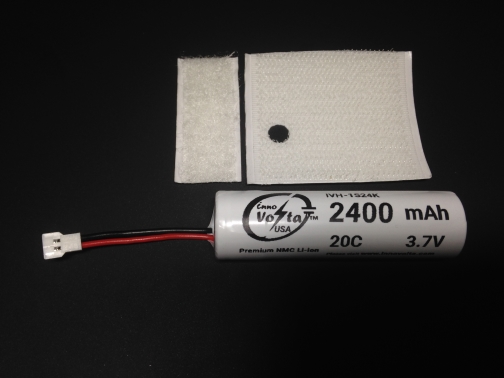
Installation Procedures:
- Connect the Walkera connector to the charger provided by SYMA or an equivalent CC/CV charger, charge the IVH-1S24K high drain battery in full. [Note: The SYMA stocked charger is not a CC/CV charger! It functions like a 0.8A (max) switching power supply, which may over-charge the battery. Please monitor the battery voltage and disconnect the battery when its voltage is about 4.25 V.]
- Remove the video camera and the battery door. (Look for easy instructions from many YouTubers)
- Apply the “50 mm x 45 mm” velcro-like strip (with tiny flexible hooks) by pressing it tightly to the bottom center of the quadcopter as shown in the next photo.
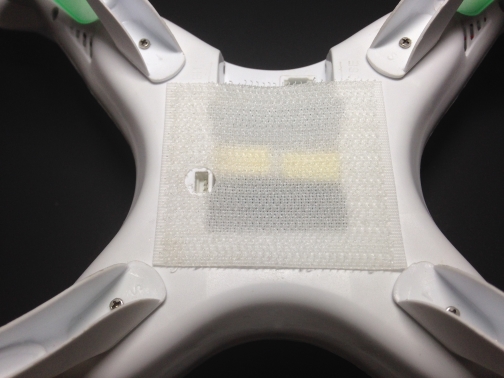
- Apply the “16 mm x 45 mm” velcro-like strip (with tiny filament loops) by pressing it tightly to the side center of the IVH-1S24K high drain battery as shown in the next photo.
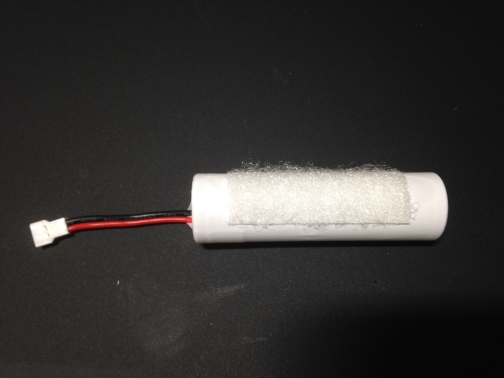
- Plug in the Walkera power plug to the Walkera power socket on the quadcopter when the power switch is off.
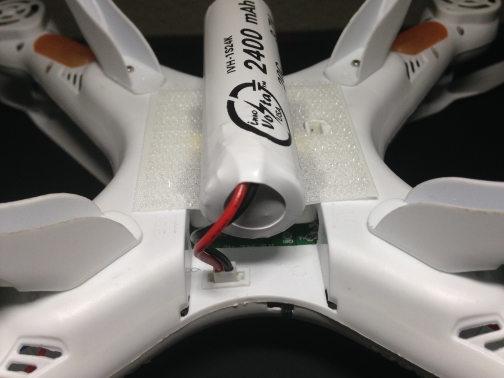
- Align the battery side center symmetrically to the bottom center of the quadcopter and adhere the battery to the bottom center of the quadcopter with velcro-like strips as shown in the next photo. To increase the holding reliability, it is recommended that the battery is adhered to the quadcopter’s body by adding a loop of adhesive tape.
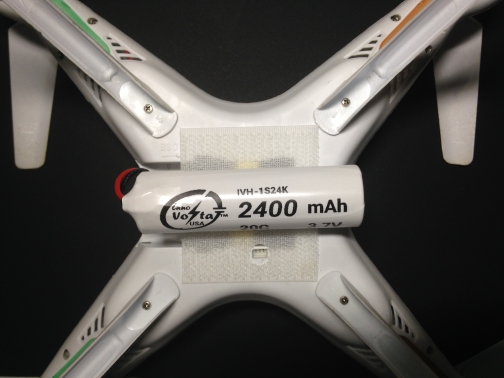
- Now! You are ready to fly the upgraded SYMA quadcopter like a pro. Our flying experiments show that it normally flies for about 20 minutes and can soar into the high sky and fly stably over 50′ ~ 100′ high, where normally has strong wind much over 5 mph.
- If you want to navigate the broad aerial surroundings, you may need the IVH-1S24K2 kit (see next photo) and use the two extra velcro-like strips to adhere the 10.2 g video camera to the bottom center of the IVH-1S24K battery. To increase the holding reliability, it is recommended that the video camera and the battery is adhered to the quadcopter’s body by adding a loop of adhesive tape.
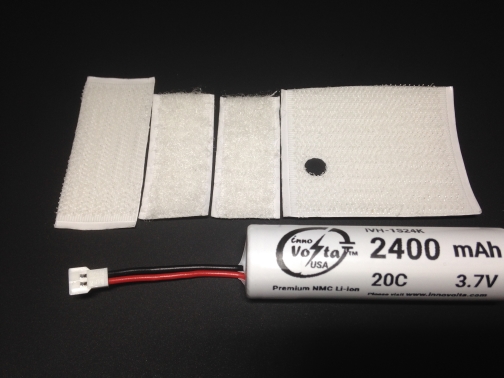
At present, we only develop the IVH-1S24K battery kit for upgrading the SYMA X5SW quadcopter. If you have other quadcopter and want to fly it like a pro, please contact us with your quadcopter model and tell us what functions you are seeking to upgrade your quadcopter. Our application engineers will address your requests and provide a solution to optimize your quadcopter soon after we receive a few of upgrade requests relating to your quadcopter model. Once we initiate the R&D, we will update the status with experimental data and let you know when your desired flying goals will come true.
As a professional B2B battery pack solution provider to industrial clients, you are welcome to email your inquiry to [email protected]. InnoVolta is capable of optimizing a set of battery pack and charger to meet the strict requirement of your industrial applications.
